Mechanical and Microstructural Response of Iron Ore Tailings under Low and High Pressures Considering a Wide Range of Molding Characteristics
Abstract
:1. Introduction
2. Experimental Program
3. Materials
4. Methods
4.1. Molding Characteristics
4.2. Specimen Molding and Curing
4.3. One-Dimensional Compression Tests
4.4. Triaxial Tests
4.5. Particle Breakage Analysis
5. Results and Discussions
5.1. One-Dimensional Compression Tests
5.2. Triaxial Tests
5.2.1. Stress–Strain Data
5.2.2. Effect of Molding Characteristics
5.3. Particle Breakage Analysis
6. Concluding Remarks
- Despite the non-convergent behavior of all samples up to the attained vertical stress (σ’v = 6400 kPa), as indicated by the different compression index values between the denser and looser samples, the studied iron ore tailings appear to be non-transitional since a near-zero m parameter value was obtained. This indicates that fabric-related differences resulting from various molding conditions (such as compaction degree, initial moisture content, and cement addition) diminish at higher stress levels during one-dimensional compression.
- The molding characteristics appeared to have significantly influenced the stress–strain response of the triaxial tests considering the lowest confining pressure (p’0 = 300 kPa). At the highest confinement level (p’0 = 3000 kPa), most of the cement bonds were broken during the consolidation phase, exerting a marginal effect on the shearing phase.
- For lower confinement levels, the cement addition appears to be an interesting option to enhance the strength and stiffness of the compacted iron ore tailings. Compacting the samples at the optimum conditions maximizes the top strength. In contrast, the initial stiffness is enhanced when the compaction is performed on the dry side of the compaction curve.
- The one-dimensional compression tests did not reveal substantial particle breakage, regardless of the initial molding characteristics. On the other side, shearing at p’0 = 3000 kPa generated a considerable grain breakage, particularly in the densest samples. In this regard, the cement addition appeared to have exerted a marginal influence concerning preventing particle breakage due to shearing at p’0 = 3000 kPa.
- Despite the differences arising from using distinct compaction characteristics, the overall volume change response was not profoundly altered by adding cement and altering the molding moisture content. In other words, all the specimens sheared at p’0 = 300 kPa initially contracted and then dilated, whereas all the specimens sheared at p’0 = 3000 kPa contracted.
- The durability of artificially cemented filtered iron ore tailings is relevant for adequately designing and maintaining dry stacking facilities. Particularly those submitted to harsh environmental conditions. Therefore, it is an exciting topic for future research.
Author Contributions
Funding
Data Availability Statement
Acknowledgments
Conflicts of Interest
Notations
| γ d | dry unit weight |
| γs | unit weight of solids of the iron ore tailings |
| w | moisture content |
| G | initial shear modulus |
| γ | bulk density |
| 1-D | one-dimensional |
| CID | consolidated isotropically drained |
| SEM | scanning electron microscope |
| XRD | X-ray diffraction |
| XRF | X-ray fluorescence |
| IOT | iron ore tailings |
| NCL | normal compression line |
| M | modified compaction energy |
| S | standard compaction energy |
| W | wet side |
| D | dry side |
| O | optimum molding conditions |
| e0 | molding void ratio |
| ec | after consolidation, the void ratio |
| Bf | breakage factor |
| C | amount of cement expressed in percentage |
| Cc | compression index |
| p’ | mean effective stress |
| p’0 | initial mean effective stress |
| q | deviatoric stress |
| qmax | peak deviatoric stress |
| εa | axial strain |
| εv | volumetric strain |
| εs | distortional strain |
| σ’v | vertical stress |
| σ1, σ3 | principal stresses |
References
- Cacciuttolo Vargas, C.; Pérez Campomanes, G. Practical Experience of Filtered Tailings Technology in Chile and Peru: An Environmentally Friendly Solution. Minerals 2022, 12, 889. [Google Scholar] [CrossRef]
- Gomes, R.B.; De Tomi, G.; Assis, P.S. Iron Ore Tailings Dry Stacking in Pau Branco Mine, Brazil. J. Mater. Res. Technol. 2016, 5, 339–344. [Google Scholar] [CrossRef]
- Bedin, J.; Schnaid, F.; Da Fonseca, A.V.; Costa Filho, L.D.M. Gold Tailings Liquefaction under Critical State Soil Mechanics. Géotechnique 2012, 62, 263–267. [Google Scholar] [CrossRef]
- Carrera, A.; Coop, M.; Lancellotta, R. Influence of Grading on the Mechanical Behaviour of Stava Tailings. Géotechnique 2011, 61, 935–946. [Google Scholar] [CrossRef]
- Oldecop, L.; Rodari, G. Unsaturated Mine Tailings Disposal. Soils Rocks 2021, 44, 1–12. [Google Scholar] [CrossRef]
- Schaper, D.; Lessa, R.; Freitas, A.; Weeks, B. De-Characterization and Closure of TSF: Concepts of the Brazilian Legislation and International Criteria. Plan. Clos. 2020, 3. [Google Scholar]
- Armstrong, M.; Petter, R.; Petter, C. Why Have so Many Tailings Dams Failed in Recent Years? Resour. Policy 2019, 63, 101412. [Google Scholar] [CrossRef]
- Islam, K.; Murakami, S. Global-Scale Impact Analysis of Mine Tailings Dam Failures: 1915–2020. Glob. Environ. Chang. 2021, 70, 102361. [Google Scholar] [CrossRef]
- Lyu, Z.; Chai, J.; Xu, Z.; Qin, Y.; Cao, J. A Comprehensive Review on Reasons for Tailings Dam Failures Based on Case History. Adv. Civ. Eng. 2019, 2019, 4159306. [Google Scholar] [CrossRef]
- Dauce, P.D.; De Castro, G.B.; Lima, M.M.F.; Lima, R.M.F. Characterisation and Magnetic Concentration of an Iron Ore Tailings. J. Mater. Res. Technol. 2019, 8, 1052–1059. [Google Scholar] [CrossRef]
- Vilaça, A.S.I.; Simão, L.; Montedo, O.R.K.; Novaes de Oliveira, A.P.; Raupp-Pereira, F. Waste Valorization of Iron Ore Tailings in Brazil: Assessment Metrics from a Circular Economy Perspective. Resour. Policy 2022, 75, 102477. [Google Scholar] [CrossRef]
- Kossoff, D.; Dubbin, W.E.; Alfredsson, M.; Edwards, S.J.; Macklin, M.G.; Hudson-Edwards, K.A. Mine Tailings Dams: Characteristics, Failure, Environmental Impacts, and Remediation. Appl. Geochem. 2014, 51, 229–245. [Google Scholar] [CrossRef]
- Santamarina, J.C.; Torres-Cruz, L.A.; Bachus, R.C. Why Coal Ash and Tailings Dam Disasters Occur. Science 2019, 364, 526–528. [Google Scholar] [CrossRef] [PubMed]
- Ahmed, S.I.; Siddiqua, S.; Renner, S. Development of a Model to Predict Consolidation of Tailings. Environ. Geotech. 2018, 5, 271–284. [Google Scholar] [CrossRef]
- Ledesma, O.; Sfriso, A.; Manzanal, D. Procedure for Assessing the Liquefaction Vulnerability of Tailings Dams. Comput. Geotech. 2022, 144, 104632. [Google Scholar] [CrossRef]
- Bruschi, G.J.; Dos Santos, C.P.; Tonini de Araújo, M.; Ferrazzo, S.T.; Marques, S.F.V.; Consoli, N.C. Green Stabilization of Bauxite Tailings: Mechanical Study on Alkali-Activated Materials. J. Mater. Civ. Eng. 2021, 33, 06021007. [Google Scholar] [CrossRef]
- Consoli, N.C.; Da Silva, A.P.; Nierwinski, H.P.; Sosnoski, J. Durability, Strength, and Stiffness of Compacted Gold Tailings—Cement Mixes. Can. Geotech. J. 2018, 55, 486–494. [Google Scholar] [CrossRef]
- Consoli, N.C.; Vogt, J.C.; Silva, J.P.S.; Chaves, H.M.; Scheuermann Filho, H.C.; Moreira, E.B.; Lotero, A. Behaviour of Compacted Filtered Iron Ore Tailings–Portland Cement Blends: New Brazilian Trend for Tailings Disposal by Stacking. Appl. Sci. 2022, 12, 836. [Google Scholar] [CrossRef]
- Festugato, L.; Fourie, A.; Consoli, N.C. Cyclic Shear Response of Fibre-Reinforced Cemented Paste Backfill. Géotech. Lett. 2013, 3, 5–12. [Google Scholar] [CrossRef]
- Pereira dos Santos, C.; Bruschi, G.J.; Mattos, J.R.G.; Consoli, N.C. Stabilization of Gold Mining Tailings with Alkali-Activated Carbide Lime and Sugarcane Bagasse Ash. Transp. Geotech. 2022, 32, 100704. [Google Scholar] [CrossRef]
- Schnaid, F.; Prietto, P.D.M.; Consoli, N.C. Characterization of Cemented Sand in Triaxial Compression. J. Geotech. Geoenviron. Eng. 2001, 127, 857–868. [Google Scholar] [CrossRef]
- Lade, P.V.; Trads, N. The Role of Cementation in the Behaviour of Cemented Soils. Geotech. Res. 2014, 1, 111–132. [Google Scholar] [CrossRef]
- Rotta, G.V.; Consoli, N.C.; Prietto, P.D.M.; Coop, M.R.; Graham, J. Isotropic Yielding in an Artificially Cemented Soil Cured under Stress. Géotechnique 2003, 53, 493–501. [Google Scholar] [CrossRef]
- Behera, S.; Mishra, D.; Singh, P.; Mishra, K.; Mandal, S.K.; Ghosh, C.; Kumar, R.; Mandal, P.K. Utilization of mill tailings, fly ash and slag as mine paste backfill material: Review and future perspective. Constr. Build. Mater. 2021, 309, 120–125. [Google Scholar] [CrossRef]
- Ercikdi, B.; Cihangir, F.; Kesimal, A.; Deveci, H. Practical Importance of Tailings for Cemented Paste Backfill. In Paste Tailings Management; Yilmaz, E., Fall, M., Eds.; Springer International Publishing: Cham, Switzerland, 2017; pp. 7–32. ISBN 978-3-319-39680-4. [Google Scholar]
- Jiang, H.; Fall, M. Yield stress and strength of saline cemented tailings in sub-zero environments: Portland cement paste backfill. Int. J. Miner. Process. 2017, 160, 68–75. [Google Scholar] [CrossRef]
- Kasap, T.; Yilmaz, E.; Guner, N.U.; Sari, M. Recycling Dam Tailings as Cemented Mine Backfill: Mechanical and Geotechnical Properties. Adv. Mater. Sci. Eng. 2022, 2022, 6993068. [Google Scholar] [CrossRef]
- Mitchell, R.J.; Olsen, R.S.; Smith, J.D.; Li, L.; Aubertin, M.; Thompson, B.; Bawden, W.; Grabinsky, M. Model studies on cemented tailings used in mine backfill. Can. Geotech. J. 1982, 19, 14–28. [Google Scholar] [CrossRef]
- Qi, C.; Fourie, A. Cemented paste backfill for mineral tailings management: Review and future perspectives. Miner. Eng. 2019, 144, 106025. [Google Scholar] [CrossRef]
- ASTM D7928; Test Method for Particle-Size Distribution (Gradation) of Fine-Grained Soils Using the Sedimentation (Hydrometer) Analysis. ASTM International: West Conshohocken, PA, USA, 2021.
- ASTM D4318; Test Methods for Liquid Limit, Plastic Limit, and Plasticity Index of Soils. ASTM International: West Conshohocken, PA, USA, 2017.
- ASTM D854; Test Methods for Specific Gravity of Soil Solids by Water Pycnometer. ASTM International: West Conshohocken, PA, USA, 2014.
- ASTM D2487; Practice for Classification of Soils for Engineering Purposes (Unified Soil Classification System). ASTM International: West Conshohocken, PA, USA, 2017.
- ASTM D698; Test Methods for Laboratory Compaction Characteristics of Soil Using Standard Effort (12,400 Ft-Lbf/Ft3 (600 KN-m/M3)). ASTM International: West Conshohocken, PA, USA, 2021.
- ASTM D1557; Test Methods for Laboratory Compaction Characteristics of Soil Using Modified Effort (56,000 Ft-Lbf/Ft3 (2700 KN-m/M3)). ASTM International: West Conshohocken, PA, USA, 2021.
- Carmignano, O.; Vieira, S.; Teixeira, A.P.; Lameiras, F.; Brandão, P.R.; Lago, R. Iron Ore Tailings: Characterization and Applications. J. Braz. Chem. Soc. 2021, 32, 1895–1911. [Google Scholar] [CrossRef]
- Chang, N.; Heymann, G.; Clayton, C. The Effect of Fabric on the Behaviour of Gold Tailings. Géotechnique 2011, 61, 187–197. [Google Scholar] [CrossRef]
- Nie, W.; Li, C.; Hu, J.; Saffari, P.; Wang, W.; Luo, M. Spatial Variation of Physical and Mechanical Properties of Tailings under Different Rainfall Intensities and the Interaction Pattern. Geomech. Geophys. Geo-Energy Geo-Resour. 2023, 9, 86. [Google Scholar] [CrossRef]
- Li, Y.; Otsubo, M.; Kuwano, R. Evaluation of Soil Fabric Using Elastic Waves during Load-Unload. J. Rock Mech. Geotech. Eng. 2023, 15, 2687–2700. [Google Scholar] [CrossRef]
- Shaker, A.A.; Elkady, T.Y. Hydraulic Performance of Sand–Clay Mixtures: Soil Fabric Perspective. Géotech. Lett. 2015, 5, 198–204. [Google Scholar] [CrossRef]
- Yimsiri, S.; Soga, K. Effects of Soil Fabric on Behaviors of Granular Soils: Microscopic Modeling. Comput. Geotech. 2011, 38, 861–874. [Google Scholar] [CrossRef]
- ASTM D2435; Test Methods for One-Dimensional Consolidation Properties of Soils Using Incremental Loading. ASTM International: West Conshohocken, PA, USA, 2011.
- ASTM D7181; Test Method for Consolidated Drained Triaxial Compression Test for Soils. ASTM International: West Conshohocken, PA, USA, 2020.
- Clayton, C.R.I.; Khatrush, S.A. A New Device for Measuring Local Axial Strains on Triaxial Specimens. Géotechnique 1986, 36, 593–597. [Google Scholar] [CrossRef]
- Nakata, A.F.L.; Hyde, M.; Hyodo, H.; Murata. A Probabilistic Approach to Sand Particle Crushing in the Triaxial Test. Géotechnique 1999, 49, 567–583. [Google Scholar] [CrossRef]
- Li, W.; Coop, M.R. Mechanical Behaviour of Panzhihua Iron Tailings. Can. Geotech. J. 2019, 56, 420–435. [Google Scholar] [CrossRef]
- Ponzoni, E.; Nocilla, A.; Coop, M.R.; Colleselli, F. Identification and Quantification of Transitional Modes of Behaviour in Sediments of Venice Lagoon. Géotechnique 2014, 64, 694–708. [Google Scholar] [CrossRef]
- Todisco, M.C.; Coop, M.R. Quantifying “Transitional” Soil Behaviour. Soils Found. 2019, 59, 2070–2082. [Google Scholar] [CrossRef]
- Malandraki, V.; Toll, D. Drained Probing Triaxial Tests on a Weakly Bonded Artificial Soil. Géotechnique 2000, 50, 141–151. [Google Scholar] [CrossRef]
- Alvarado, G.; Coop, M.R.; Willson, S. On the Role of Bond Breakage Due to Unloading in the Behaviour of Weak Sandstones. Géotechnique 2012, 62, 303–316. [Google Scholar] [CrossRef]
- Alvarado, G.; Lui, N.; Coop, M.R. Effect of Fabric on the Behaviour of Reservoir Sandstones. Can. Geotech. J. 2012, 49, 1036–1051. [Google Scholar] [CrossRef]
- Reza Fotovvat, A.; Sadrekarimi, A. Instability of a Gold Mine Tailings Subjected to Different Stress Paths. J. Geotech. Geoenviron. Eng. 2022, 148, 04022020. [Google Scholar] [CrossRef]
- Salvatore, E.; Modoni, G.; Andò, E.; Albano, M.; Viggiani, G. Determination of the Critical State of Granular Materials with Triaxial Tests. Soils Found. 2017, 57, 733–744. [Google Scholar] [CrossRef]
- Wagner, A.C.; De Sousa Silva, J.P.; De Azambuja Carvalho, J.V.; Cezar Rissoli, A.L.; Cacciari, P.P.; Chaves, H.M.; Scheuermann Filho, H.C.; Consoli, N.C. Mechanical Behavior of Iron Ore Tailings under Standard Compression and Extension Triaxial Stress Paths. J. Rock Mech. Geotech. Eng. 2023, 15, 1883–1894. [Google Scholar] [CrossRef]
- Lade, P.V.; Overton, D.D. Cementation Effects in Frictional Materials. J. Geotech. Eng. 1989, 115, 1373–1387. [Google Scholar] [CrossRef]
- Kikumoto, M.; Wood, D.M.; Russell, A. Particle Crushing and Deformation Behaviour. Soils Found. 2010, 50, 547–563. [Google Scholar] [CrossRef]
- Zhang, T.; Yang, W.; Zhang, C.; Hu, C. Particle Breakage Effect on Compression Behavior of Realistic Granular Assembly. Int. J. Geomech. 2021, 21, 04021105. [Google Scholar] [CrossRef]
- Wei, H.; Li, X.; Zhang, S.; Zhao, T.; Yin, M.; Meng, Q. Influence of Particle Breakage on Drained Shear Strength of Calcareous Sands. Int. J. Geomech. 2021, 21, 04021118. [Google Scholar] [CrossRef]



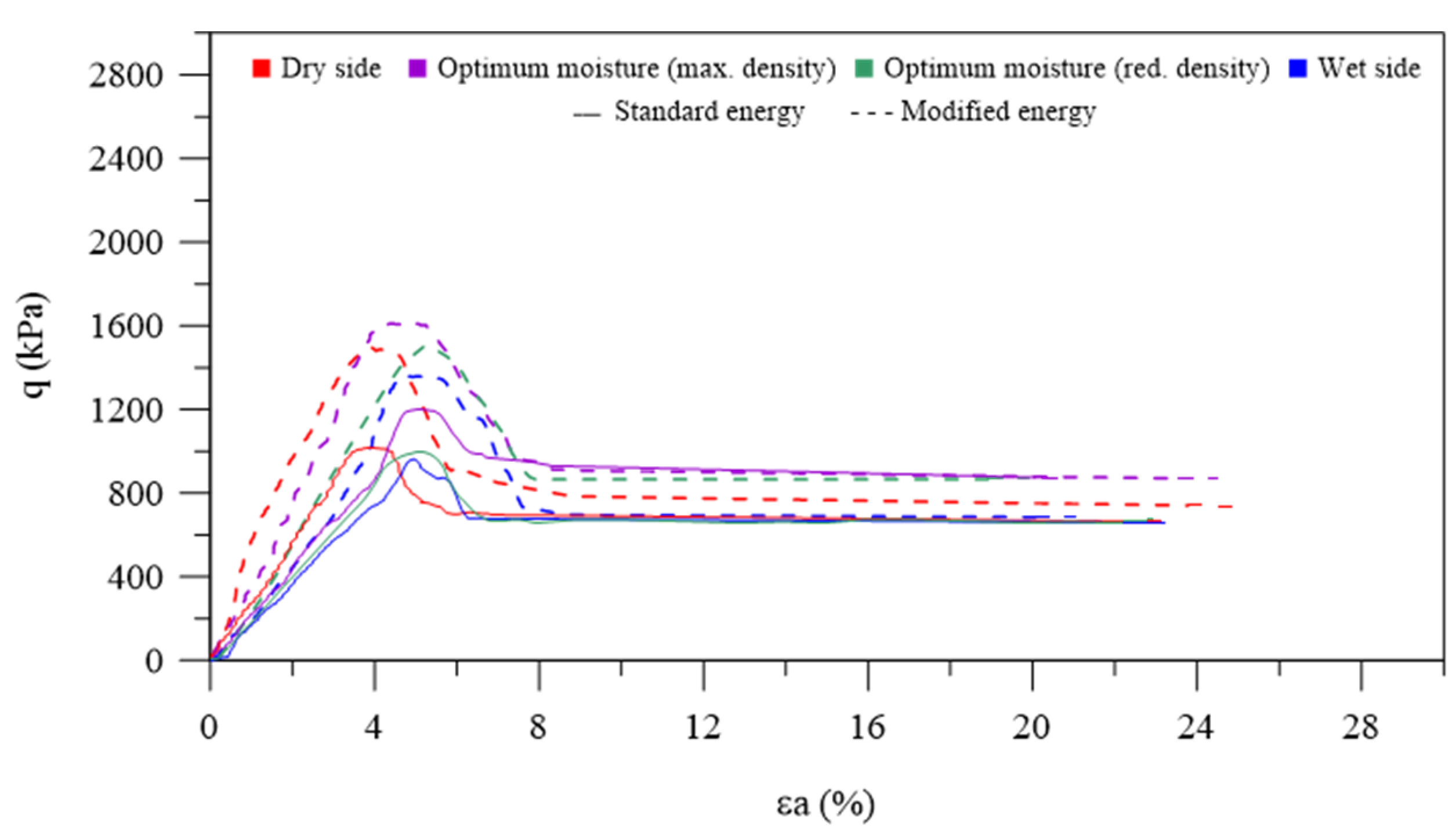
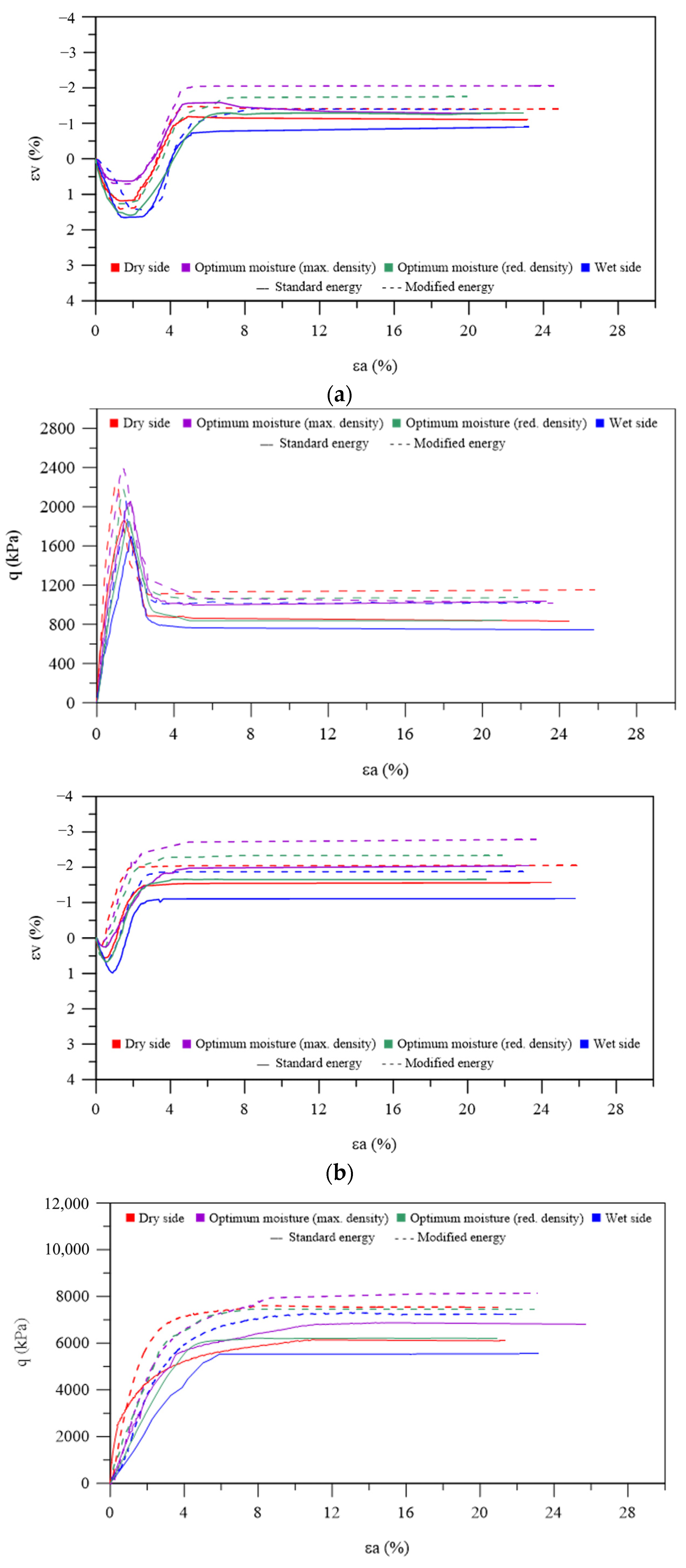
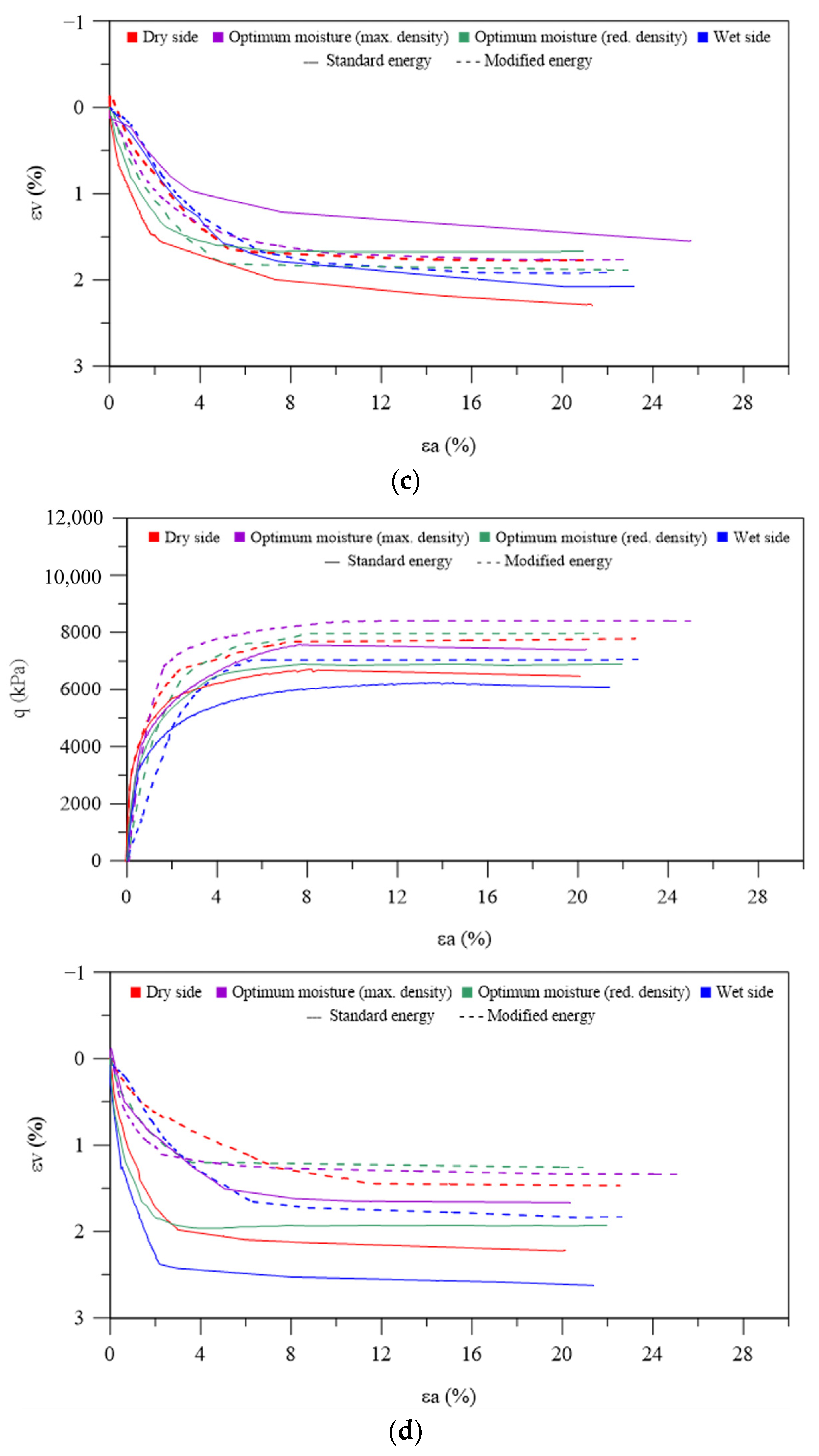
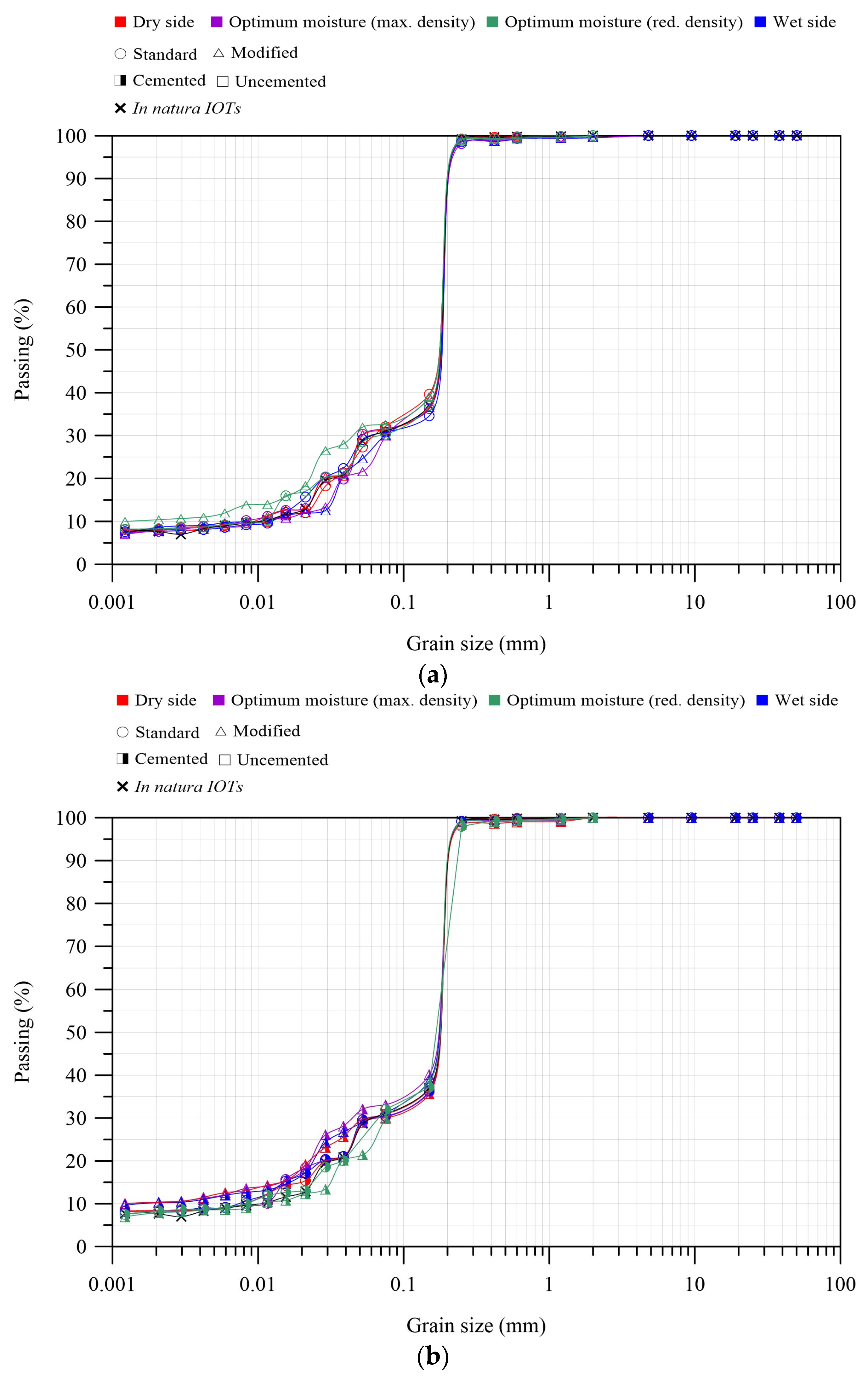

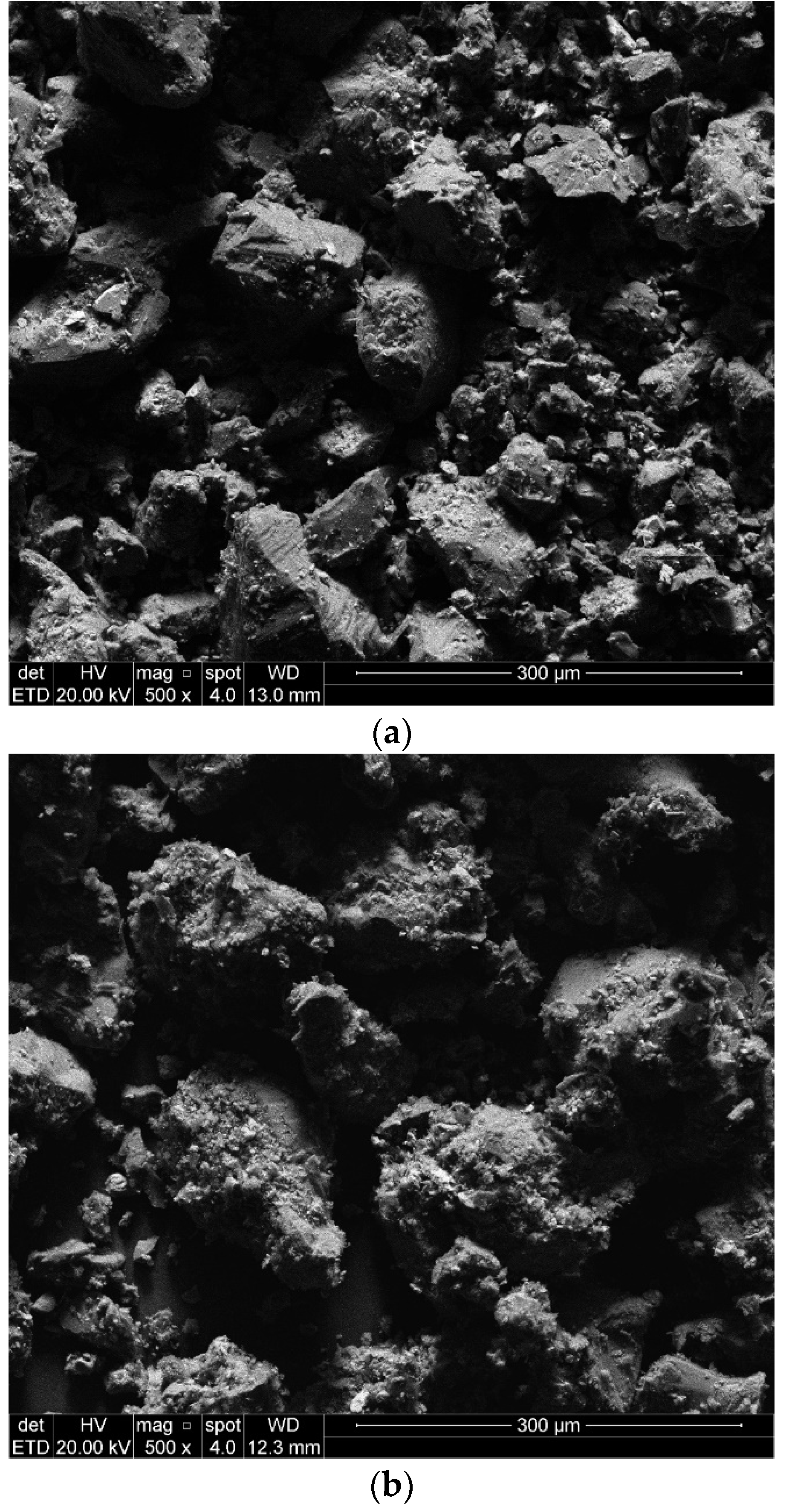

| Physical Properties | Iron Ore Tailings | Test Method |
|---|---|---|
| Liquid limit (%) | - | ASTM D4318 |
| Plastic limit (%) | - | |
| Plastic index (%) | non-plastic | |
| Specific gravity | 2.72 | ASTM D854 |
| Coarse Sand (2.00 mm < diameter < 4.75 mm) (%) | 0.0 | ASTM D7928 |
| Medium Sand (0.425 mm < diameter < 2.00 mm) (%) | 0.0 | |
| Fine Sand (0.075 mm < diameter < 0.425 mm) (%) | 8.0 | |
| Silt (0.002 < diameter < 0.075 mm) (%) | 88.7 | |
| Clay (diameter < 0.002 mm) (%) | 3.3 | |
| Maximum dry unit weight at standard effort (kN/m3) | 17.4 (w = 15.2%) | ASTM D1557 |
| Maximum dry unit weight at modified effort (kN/m3) | 18.5 (w = 11.6%) | ASTM D698 |
| Specimen | e0 | e6400 | Cc |
|---|---|---|---|
| S_W_3C | 0.605 | 0.412 | 0.14 |
| S_O_3C | 0.568 | 0.422 | 0.14 |
| S_R_3C | 0.608 | 0.428 | 0.14 |
| S_D_3C | 0.610 | 0.427 | 0.14 |
| M_W_3C | 0.512 | 0.410 | 0.10 |
| M_O_3C | 0.471 | 0.408 | 0.07 |
| M_R_3C | 0.511 | 0.412 | 0.11 |
| M_D_3C | 0.509 | 0.414 | 0.10 |
| S_W_0C | 0.603 | 0.412 | 0.11 |
| S_O_0C | 0.566 | 0.403 | 0.14 |
| S_R_0C | 0.608 | 0.421 | 0.12 |
| S_D_0C | 0.609 | 0.421 | 0.12 |
| M_W_0C | 0.512 | 0.426 | 0.04 |
| M_O_0C | 0.473 | 0.419 | 0.04 |
| M_R_0C | 0.514 | 0.421 | 0.04 |
| M_D_0C | 0.514 | 0.422 | 0.04 |
| Specimen | p’0 (kPa) | e0 | ec | Gεs = 0.5% (MPa) |
|---|---|---|---|---|
| S_W_3C | 300 kPa | 0.59 | 0.57 | 56.1 |
| S_O_3C | 0.54 | 0.53 | 63.8 | |
| S_R_3C | 0.58 | 0.57 | 68.8 | |
| S_D_3C | 0.58 | 0.57 | 76.6 | |
| M_W_3C | 0.49 | 0.49 | 63.1 | |
| M_O_3C | 0.44 | 0.43 | 75.2 | |
| M_R_3C | 0.44 | 0.43 | 83.5 | |
| M_D_3C | 0.49 | 0.47 | 88.8 | |
| S_W_0C | 0.58 | 0.57 | 7.5 | |
| S_O_0C | 0.54 | 0.53 | 9.4 | |
| S_R_0C | 0.58 | 0.57 | 11.1 | |
| S_D_0C | 0.58 | 0.56 | 15.2 | |
| M_W_0C | 0.48 | 0.48 | 21.4 | |
| M_O_0C | 0.44 | 0.43 | 9.8 | |
| M_R_0C | 0.44 | 0.43 | 11.2 | |
| M_D_0C | 0.48 | 0.47 | 38.5 | |
| S_W_3C | 3000 kPa | 0.59 | 0.41 | 188.5 |
| S_O_3C | 0.54 | 0.43 | 261.5 | |
| S_R_3C | 0.58 | 0.43 | 282.4 | |
| S_D_3C | 0.58 | 0.43 | 303.9 | |
| M_W_3C | 0.49 | 0.42 | 170.5 | |
| M_O_3C | 0.44 | 0.41 | 264.7 | |
| M_R_3C | 0.48 | 0.42 | 221.5 | |
| M_D_3C | 0.49 | 0.41 | 351.3 | |
| S_W_0C | 0.58 | 0.43 | 33.5 | |
| S_O_0C | 0.54 | 0.43 | 66.6 | |
| S_R_0C | 0.58 | 0.43 | 69.8 | |
| S_D_0C | 0.58 | 0.42 | 146.6 | |
| M_W_0C | 0.48 | 0.43 | 46.8 | |
| M_O_0C | 0.44 | 0.40 | 71.6 | |
| M_R_0C | 0.48 | 0.42 | 74.8 | |
| M_D_0C | 0.48 | 0.41 | 109.7 |
| Specimen | Particle Breakage Factor (Bf) | |
|---|---|---|
| Test Type | ||
| 1-D Comp. | Triaxial | |
| S_W_3C | 0.02 | 0.04 |
| S_O_3C | 0.02 | 0.10 |
| S_R_3C | 0.01 | 0.08 |
| S_D_3C | 0.02 | 0.11 |
| M_W_3C | 0.01 | 0.10 |
| M_O_3C | 0.01 | 0.14 |
| M_R_3C | 0.02 | 0.11 |
| M_D_3C | 0.01 | 0.19 |
| S_W_0C | 0.00 | 0.05 |
| S_O_0C | 0.00 | 0.09 |
| S_R_0C | 0.00 | 0.07 |
| S_D_0C | 0.00 | 0.12 |
| M_W_0C | 0.00 | 0.10 |
| M_O_0C | 0.00 | 0.13 |
| M_R_0C | 0.00 | 0.11 |
| M_D_0C | 0.00 | 0.19 |
Disclaimer/Publisher’s Note: The statements, opinions and data contained in all publications are solely those of the individual author(s) and contributor(s) and not of MDPI and/or the editor(s). MDPI and/or the editor(s) disclaim responsibility for any injury to people or property resulting from any ideas, methods, instructions or products referred to in the content. |
© 2023 by the authors. Licensee MDPI, Basel, Switzerland. This article is an open access article distributed under the terms and conditions of the Creative Commons Attribution (CC BY) license (https://creativecommons.org/licenses/by/4.0/).
Share and Cite
Bruschi, G.J.; Santos, C.P.D.; Filho, H.C.S.; da Silva Martinatto, C.; Schulz, L.R.; Silva, J.P.d.S.; Consoli, N.C. Mechanical and Microstructural Response of Iron Ore Tailings under Low and High Pressures Considering a Wide Range of Molding Characteristics. Mining 2023, 3, 712-730. https://doi.org/10.3390/mining3040039
Bruschi GJ, Santos CPD, Filho HCS, da Silva Martinatto C, Schulz LR, Silva JPdS, Consoli NC. Mechanical and Microstructural Response of Iron Ore Tailings under Low and High Pressures Considering a Wide Range of Molding Characteristics. Mining. 2023; 3(4):712-730. https://doi.org/10.3390/mining3040039
Chicago/Turabian StyleBruschi, Giovani Jordi, Carolina Pereira Dos Santos, Hugo Carlos Scheuermann Filho, Camila da Silva Martinatto, Luana Rutz Schulz, João Paulo de Sousa Silva, and Nilo Cesar Consoli. 2023. "Mechanical and Microstructural Response of Iron Ore Tailings under Low and High Pressures Considering a Wide Range of Molding Characteristics" Mining 3, no. 4: 712-730. https://doi.org/10.3390/mining3040039
APA StyleBruschi, G. J., Santos, C. P. D., Filho, H. C. S., da Silva Martinatto, C., Schulz, L. R., Silva, J. P. d. S., & Consoli, N. C. (2023). Mechanical and Microstructural Response of Iron Ore Tailings under Low and High Pressures Considering a Wide Range of Molding Characteristics. Mining, 3(4), 712-730. https://doi.org/10.3390/mining3040039











